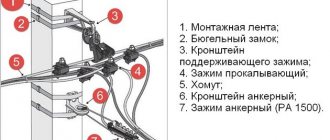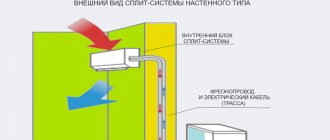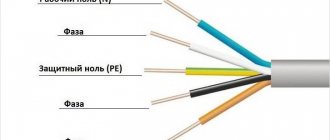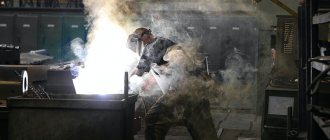When building his own home, every owner must take care of its arrangement and comfort. The first step is to connect it to the power supply. The legislation allows the consumption of electricity of different power depending on the energy consumed. Therefore, you must first determine the resource consumption, and then determine what cross-section of the central cable will be required to install the outlet to your home.
Today, people use many electrical appliances that they need for a comfortable life and convenience. They consume a lot of electrical resources. A private house is usually allocated a power of 15 kW, which is enough to fully use electricity without overloading the power grid.
What kind of sip is needed for a private house?
For entry into the house, SIP 4 is used without a supporting cable with conductors of the same cross-section of 16 square meters. mm. SIP is an aluminum cable, and the use of aluminum with a cross-section of less than 16 square meters. mm.
Interesting materials:
How to withdraw money from the account of a deceased person? How to get money for playing on Steam? How to transfer money through the terminal to Kaspi Gold? How to transfer money to Alga? How to earn 1000 rubles a day? How to make money from reviews on IRecommend? How to earn points in JOOM? How to earn Vodafone bonuses? How to make money in GTA 5 on PS 3? How to make money playing games?
Types of cable for a 15 kW network
You need to know which cable to use to enter a private house: 3-phase or single-phase. Connecting using the first option implies reducing the load on the network and the rating of the input machine. The disadvantage is that the size of the distribution panel will be larger than with a single-phase connection, since the power switches will occupy 3-4 modules.
Also, three-phase residual current devices are larger in size. But this type of input cable makes it possible to connect asynchronous electrical devices, boilers, electric stoves or heating systems to the house.
Since the voltage in a three-phase network is 380 V, for protection you will need a three-way circuit breaker before entering the network into the house. It will help avoid the risk of fire and electric shock, and also provide protection against short circuits in the electrical network. Wires differ in the material from which the core is made. Copper cables have lower resistance than aluminum cables, but are more expensive.
Sectional view of 15 kW wire Source elektrik-a.su
Cables for power supply differ in the type of input:
- Airy . For this purpose, the AVK, SIP or AVVG (VVG) models are used. They have the ability to transmit current up to 1 kV and withstand temperatures from -50 to +48 ° C. The disadvantage of the air input is the use of jumpers necessary for the normal connection of the cable to the shield. The rules for wiring the electrical network indicate that such jumpers are unacceptable, but if this point is agreed upon by the supplier company, then when the connection is installed, a seal will be placed on it.
- Underground . For this type of connection, AVBbShV (aluminum) or VBBShV (copper) wire with an armored coating, galvanized tape and a protective hose is used. This is necessary to protect the cable from ground fault or mechanical damage.
For each type of connection there are certain connection and installation standards. If the cable is not installed correctly, all electrical devices may be subject to a short circuit or breakage from voltage surges, since improper power distribution leads to inefficient use of the network.
3 phases and zero Source isu.org.ua
See also: Catalog of companies that specialize in the installation of electrical networks
BKZ marking
The BKZ marking reflects all the features of their manufacture. To mark BKZ, alphabetic and digital identifiers are used:
- letter identifiers indicate the type of material: TZ, insulating layers, armor shell, screens, outer cover;
- digital identifiers transmit information about other features of the cable product, for example, the number of current-carrying cores, their cross-section and permissible voltage.
Letter abbreviation in the current marking system
BKZ is used as follows:
- To designate TZh material:
- aluminum conductors – (A);
- copper conductors – no designation.
- To designate the insulation material TZh:
- PVC insulation – (B);
- polyethylene insulation – (Pv);
- polymer composition – (P).
- To designate the armor material and its design:
- steel belt - (B);
- round wire armor – (K);
- flat wire armor – (P);
- lead armor - (SB).
BKZ manufacturers use various options for armor protection, the features of which are additionally indicated when marking the cable, for example:
- BN - armor with a flame retardant coating;
- BB – armor made of profiled steel strips;
- Pa - aluminum wire, etc.
- To indicate the material and type of protective outer covering:
- (B) – if the cover is made of PVC, (Shv) – if the shell is in the form of a PVC hose;
- (P) – cover made of polyethylene, (Шп) – for a hose made of polyethylene.
When marking BKZ, letter identifiers are also used for:
- indication of the presence of a metal screen;
- information regarding fire safety;
- information on the cross-sectional shape and design of the TJ.
Common installation mistakes
Now let's pay attention to the main points during installation, which you can and should check during the work of an electrician. Firstly, the distance from the main support to the house should be no more than 25 meters
Otherwise, you will have to install additional support or make a pipe stand
Firstly, the distance from the main support to the house should be no more than 25 meters. Otherwise, you will have to install additional support or make a pipe stand.
You will also need a pipe stand if the energy supply organization does not give permission to install a metering cabinet on the facade and requires it to be placed on the nearest support.
Error No. 18 It is impossible for the clearance from the ground to the SIP wire on the facade of the house to be less than 2.5 m.
Don't be lazy, take a tape measure and check this height. If you cannot fulfill this requirement, install a gander.
Error No. 19 Do not attach the anchor bracket to the roof elements (windbreaker).
The load-bearing capacity of wood in these places is rather weak and fasteners can be torn out by the roots due to strong wind loads. Although the weight of the SIP is small, the lever, a couple of tens of meters long, does its job!
It is best to drill to the gable of the house using a good old traverse or supporting beam.
Error No. 20 It is also not recommended to attach SIP to the side wall of the building.
The point here is icicles, which in the spring often damage wires when they fall.
You can, of course, get confused and get rid of the icicles once and for all. But that's a completely different story.
The cable run to the switch cabinet must be protected with corrugation.
Error No. 21 The corrugation should not be gray as for home wiring, but resistant to ultraviolet radiation + non-flammable.
On wooden walls you need to use a metal hose.
Error No. 22 The end of the cable at the point of connection to the SIP on the facade should look down, not up.
This is protection against moisture penetration into the cut cable.
It’s even better to seal the end of the corrugation, where the wires come from, with a “TPI mini” glove from KVT.
It sticks perfectly to 25 and 32 corrugations.
If the cable goes directly into the attic, and does not go down the facade, then the entry through the wall must be made through a metal sleeve.
In this case, the tube should not be straight, but with the end bent towards the bottom.
The holes in it must be reliably sealed after inserting the cable. To protect the SIP itself from moisture, both on the support and on the facade, caps are used.
Error No. 23 If they are not there, then in a couple of years the wire, like a pump, will pick up water and very soon fail.
Here is a clear example confirming this problem.
https://youtube.com/watch?v=DWOP43hQ4zc%3F
The caps cost a penny, but without them long-term and reliable operation of the self-supporting wire is impossible. Almost every piercing clamp has such a cap in its design.
However, on some models they are attached to thin straps. It happens that the strap comes off and the cap is lost.
In this case, do not save money and be sure to buy yourself a new one. Fortunately, they are also sold separately.
Error No. 24 There is no need to remove the insulation from the cable core when connecting through a piercing clamp.
If your cable cross-section is too small (2.5mm2-4mm2, but where would such a cable go???), then the manufacturer recommends folding the core in half to ensure a larger contact area.
A thin vein can get between the spikes, and even if contact appears at first, over time this place will heat up and the cable will burn off. Cores from 6mm2 do not need to be folded in half.
The SIP itself from the support to the house, despite its insulation, must pass at least 0.5 m from the nearest trees and shrubs.
If you do not want to cut down your favorite birch or apple tree, then it is better to choose another attachment point on the facade. Any SIP passing through trees will eventually fray.
Mistake No. 25 Don’t listen to those who say that such wires can be safely run through green spaces and nothing will happen to them.
Even thick veins of 50-70 mm2 after a few years with constant winds are cut through by a branch like a hacksaw.
Here is a summary table of the minimum offsets and distances when laying SIP wires in a residential building.
https://youtube.com/watch?v=GYs2IU8b3_w%3F
General points
In order for the house to be warm, the heating system must replenish all existing heat losses in full. Heat escapes through walls, windows, floors, and roofs. That is, when calculating the boiler power, it is necessary to take into account the degree of insulation of all these parts of the apartment or house. With a serious approach, they order a calculation of the building’s heat loss from specialists, and based on the results, they select the boiler and all other parameters of the heating system. This task is not to say that it is very difficult, but it is necessary to take into account what the walls, floor, ceiling are made of, their thickness and the degree of insulation. They also take into account the cost of windows and doors, whether there is a supply ventilation system and what its performance is. In general, a long process.
There is a second way to determine heat loss. You can actually determine the amount of heat that a house/room loses using a thermal imager. This is a small device that displays the actual picture of heat loss on the screen. At the same time, you can see where the outflow of heat is greater and take measures to eliminate leaks.
Determining actual heat loss - an easier way
Now let’s talk about whether it’s worth taking a boiler with a power reserve. In general, constant operation of equipment at the limit of its capabilities negatively affects its service life. Therefore, it is advisable to have a performance reserve. Small, about 15-20% of the calculated value. It is quite enough to ensure that the equipment does not work at the limit of its capabilities.
Too much stock is not economically profitable: the more powerful the equipment, the more expensive it is. Moreover, the price difference is significant. So, if you are not considering the possibility of increasing the heated area, you should not take a boiler with a large power reserve.
FAQ
Question No. 1. Is it possible to lay cables with a much larger cross-section than calculated according to the tables?
Yes, you can if you got them for free or very cheap, otherwise it’s an extra financial expense. In this case, take into account the possibility of inserting the ends into the control panel and securing them to the contacts.
Question No. 2. If there is a cable to be laid in the ground, can I lay it over the air?
You can, but you need to take into account its increased weight, be sure to use a cable suspension and the distance between the supports is preferably up to 10 m.
Question No. 3. Is it possible to lay AVVG cable in the ground?
Yes, this cable has reliable waterproofing, but without armored tape, so it must be laid in pipes.
Question No. 4. For a 380 V network, can two AVK cables be used?
To do this, you will need to connect the coaxial sheath of one cable to the third phase, and the sheath of the second cable to the grounded neutral; such a scheme is allowed.
Question No. 5. It is prohibited to lay a cable under the foundation, but can it be laid up to the shield along the wall so as not to drip around the building?
It all depends on the specific conditions at the site; when leaving the ground, the cable up to a height of 1.8 m must be in a protective box or pipe. Walk at a distance of 90 cm from windows and doors, if these conditions are met, do it.
Choosing the right wire
Specialists from organizations that maintain power lines often, in order to save money or due to some personal preferences, use not the most suitable wires. These can be either insulated, but not intended for cable entry, or non-insulated, those that run as main lines along poles.
It is important to remember that if a bare wire was used to replace the input cable, then it should be laid securely and efficiently, because in strong winds such wires can short out. It may also happen that a truck enters the area and, while unloading, may touch the wires, which will lead to electric shock. However, someone may suggest making a replacement using insulated wire, but not intended for laying with air
In this case, due to constant sunlight, the insulation may crack and crumble over time, which is also unacceptable for an input cable
However, someone may suggest making a replacement using insulated wire, but not intended for laying with air. In this case, due to constant sunlight, the insulation may crack and crumble over time, which is also unacceptable for the input cable.
Based on the above, it is necessary to use a specially designed wire to lay the input to the house from the pole. SIP is ideal for such work because it is a self-supporting insulated conductor. It does not have the disadvantages that other wires have. We talked about how to connect a SIP wire to a house in a separate article.
Installation of the unit
To begin, you will need to install your electric boiler indoors. This process is the simplest. The unit can be installed both on the floor and on the wall. If it is installed on the floor, then you will definitely need to make a special stand.
If the electric boiler will be installed on the wall, then you will need special anchors. First you need to make markings on the wall. Remember that your holes must be placed evenly on the wall. Next you need to drill holes and insert anchors. Once the anchor is firmly placed in the wall, you can hang the boiler.
Call!
Fast and profitable technological connection.
As a rule, the question of laying a cable at the appropriate power arises when preparing a facility for commissioning. In order to connect electricity to a facility, lay a cable and install a machine, it is not enough to obtain the appropriate power. And for this, in turn, you need to contact the network company and receive technical conditions, the composition of which will determine the total cost of the technological connection in your case.
- Even if you have already received not very favorable technical conditions, but have not yet signed an agreement, we can help you! Call us and we will get you good technical conditions that will allow you to reduce the final cost of the technological connection agreement several times!
- We will also carry out all the necessary electrical installation work for you quickly and efficiently. In our work we use only modern and reliable equipment, as well as high-quality consumables. Our specialists can easily navigate any situation and guarantee you the quality of all work performed. And we guarantee you the same price throughout the entire term of the contract!
- You can also use our assistance in concluding an agreement with a sales company. We will collect a complete package of documents for you, provide it to the guaranteeing electricity supplier and conclude a contract that is beneficial for you, once and for all solving the issue of non-contractual electricity consumption.
- We will speed up the final stage of putting the facility into operation: we will quickly obtain all the necessary approvals and permits!
We count: 20 x 0.8 = 16 (kW)
To make a choice of cable cross-section based on power, look at our tables:
For a three-phase 380 Volt circuit it will look like this:
As you can see, it's not difficult. I would also like to add that I advise you to choose a cable or wire with the largest cross-section of cores, in case you want to connect something else .
Related posts:
- When Power Engineer's Day in Russia in 2012 was special.
- If you are planning to study to become an electrician, I recommend reading where to study and how to get an electrician diploma
- Electrical personnel, groups
- Electrician profession, prospects
Useful advice: if you suddenly find yourself in an unfamiliar area at night. Don't use your cell phone to light your way
That's all for me, now you know how to select the cable cross-section according to power. Feel free to share with your friends on social networks.
Connecting an electric boiler and safety rules
Connecting an electric boiler to the electrical network must follow safety rules. Here are the basic recommendations that you need to follow when performing electrical work:
- The electric boiler must be connected when the power is turned off.
- Its installation must take place at a certain distance from other objects:
- Leave 5 cm of space between the wall and the boiler.
- The front panel must be accessible to open. 60 cm is enough for this.
- The distance from the ceiling should be 75 cm.
- If the device is of a suspended type, then at least 50 cm must be left from the floor.
- The distance to the nearest pipes should be about 60 cm.
- The electric boiler must be connected to a three-phase network. If a single-phase network is installed in your house, then it simply will not withstand the load. Subsequently, a short circuit may occur.
- Wire connections must be sealed. They must be reliably protected from moisture. Also, when laying wiring for an electric boiler, experts recommend using a corrugated pipe. It will provide reliable protection and easy access to the cable. Also, if the wiring catches fire, a corrugated pipe can prevent the spread of fire.
Cable calculation
You need to know what cross-section is needed for 15 kW and 380 for input into the house, since with an aluminum and copper core it has different characteristics, and also differs with different connection methods. For open introduction at a voltage of 380 V and a power of 15 kW, a copper conductor with a cross-section of 4 mm² and capable of withstanding a current of 41 A is required, and for an aluminum wire - from 10 mm² and a current of 60 A.
For cables laid in a pipe, copper conductors must have a cross-section of 10 mm², and for aluminum conductors - from 16 mm². The length of the cable depends on the distance of the entry point to the pole, as well as the presence of additional fasteners or supports.
First of all, the wire is connected to the electricity meter Source i.ytimg.com
When will the lights be turned on?
So, you have a contract and specifications in your hands. The conditions list the measures that, by completing them, will bring the site in accordance with the requirements of the network company. Usually they are interested in the metering unit and the machines that disconnect the wires in an emergency. As a rule, the box with the meter is installed on a pole (pipe stand) on the outside of the site.
The video below shows an example of performing specifications
Pay attention to the budget pipe stand. You can install it yourself
In winter, connection is possible if the pole and wires are located close to the metering station. When additional wire supports need to be installed, the network company's lead time may be extended to one year. The deadlines for fulfillment of obligations by the parties are specified in the agreement.
Circuit breaker calculation
You can select machines based on the load current or the cross-section of the electrical wiring.
Current machine calculation
We calculate the total power of the loads on the machine. We add the power of all electricity consumers, and according to the following formula:
we obtain the calculated current of the machine.
P is the total power of all electricity consumers
U – mains voltage
We round the calculated value of the resulting current up.
Calculation of the machine according to the cross-section of the electrical wiring
To select a machine, you can use Table 1. The current selected according to the cross-section of the electrical wiring is reduced to the lower value of the current of the machine to reduce the load on the electrical wiring.
Selecting the rated current according to the cable cross-section. Table No. 1
For sockets, the machines take a current of 16 amperes, since the sockets are designed for a current of 16 amperes; for lighting, the optimal version of the machine is 10 amperes. If you do not know the cross-section of the electrical wiring, then it is easy to calculate it using the formula:
S – wire cross-section in mm²
D – wire diameter without insulation in mm
The second method of calculating the circuit breaker is more preferable, since it protects the electrical wiring in the room.
On the given simplified graph, the current ratings of the machines are indicated on the horizontal scale; on the vertical scale, the value of active power for a single-phase power supply is 220 Volts. Calculation for a voltage of 380 Volts and/or three-phase power supply will differ significantly and the given graph for others, except 220 Volts and single-phase power supply, capacity is invalid. . To select a machine that is suitable for the selected calculated power, it is enough to draw a horizontal line from the power selected on the left to the intersection with the green column, by looking at the base of which you can select the rating of the machine for the specified power. The required time current characteristic and the number of poles can be selected by following the picture to the table for selecting curve C circuit breakers, as the most universal and frequently used characteristic.
Video description
How to lay the input cable along overhead lines is shown in the video:
The first is needed to protect the cable from snow melting or falling trees. In these incidents, the fittings break, but the cable remains intact. An insulator is required to protect the jumpers, since due to the rigidity of the SIP, it cannot be directly connected to the panel. To do this, a softer cable is attached to it. Also, when connecting aluminum and copper wires, twisting is prohibited. To do this, all jumpers must be made from terminal boxes, and insulators must be used to protect them.
When tensioning the cable, it should be taken into account that its height above the pedestrian area must be at least 3.5 m, and above the roadway a distance to the ground of 5 m is required. The tension force must be adjusted using a dynamometer. The advantage of air laying is that it requires little resources to connect the cable, and it is also possible to quickly replace the wire.
The disadvantage of this type of entry is that the electrical wiring is exposed and may be subject to damage by trees, weather or other mechanical means. Hanging wires also prevent the access of large vehicles (truck cranes, aerial platforms, fire trucks).
The wire is laid along overhead linesSource samelectrik.ru











